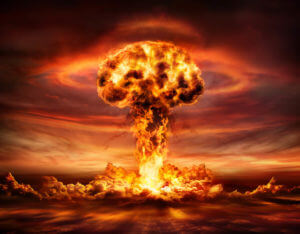
From 1946 to 1958, the United States used Bikini Atoll in the Marshall Islands for nuclear testing. This small and remote island became the site of 23 powerful explosions. These tests changed everything. They harmed the people who lived there, damaged the land and ocean, and affected future generations.
Even today, the name “Bikini Atoll” reminds us of how dangerous nuclear weapons can be. In this article, we will explore the history of these tests, the damage they caused, and the lessons we can learn.
Historical Context: Why Bikini Atoll Was Chosen
The U.S. chose Bikini Atoll for nuclear testing because of world events at the time. After World War II, the Cold War began. The United States and the Soviet Union were in a race for power. Both countries wanted to build the biggest and most powerful weapons. Nuclear bombs became a key part of their military plans.
Bikini Atoll was seen as the perfect test site. It was far away in the Pacific Ocean and did not have many people living on it. This made it an easy target for testing, at least in the eyes of government officials.
The Nuclear Tests at Bikini Atoll
From 1946 to 1958, at least 23 nuclear tests were carried out over two operations:
Operation Crossroads (1946)
The U.S. dropped two bombs named “Able” and “Baker” during this test. The goal was to see how nuclear explosions would affect Navy ships.
Operation Castle (1954)
This was the biggest U.S. nuclear test ever. The test at Castle Bravo was 15 megatons, over 1,000 times stronger than the bomb dropped on Hiroshima. In total, these tests released more than 42 megatons of nuclear energy.
Immediate Impacts on Bikini Atoll and Its People
The explosions destroyed large parts of the island. Coral reefs were wiped out, plants were flattened, and the land became toxic. Radioactive fallout spread for hundreds of miles, reaching nearby islands.
Long-Term Health Consequences of Radiation Exposure
Radiation exposure caused serious health problems for Bikini Islanders and nearby communities. Fallout included harmful materials like cesium-137 and iodine-131. These raised cancer rates and led to diseases like thyroid cancer and leukemia.
U.S. military members, known as “atomic veterans,” were also affected. Many helped with testing and cleanup, often without proper protection. Years later, many became sick with radiation-related illnesses. Today, advocacy groups are still fighting for these veterans. They seek fair compensation, proper care, and public recognition.
Environmental Contamination of Bikini Atoll
The nuclear tests left Bikini Atoll badly contaminated. Even today, it is one of the most radioactive places on Earth. Radiation is still found in the soil, water, and sea life. This makes the area unsafe for people to live or work there.
Some cleanup has been done, but it is not enough. The soil still contains high levels of cesium-137. Because of this, the land is unusable for local agriculture.
The Atoll Today
Bikini Atoll remains largely uninhabitable due to high radiation levels. Only a small number of researchers and cleanup crews visit the area. Even though the situation is still difficult, some efforts are being made to save the island’s history. These projects help future generations remember what happened and why it matters.
Survivors and their families continue to push for justice. Advocacy groups are fighting to get them fair compensation and long-term healthcare. They also support efforts to keep their culture alive, even while living far from home.
Lessons Learned from Bikini Atoll
The story of Bikini Atoll teaches us some important lessons.
Environmental and Ethical Responsibility
Bikini Atoll reminds us to take better care of the environment. Before making decisions that could have lasting effects, governments must carefully study the risks. They should also listen to and involve the people who will be affected.
Recognition and Compensation
Many people, including atomic veterans and displaced islanders, were harmed by nuclear testing. They deserve fair payments and proper care. Helping them is not just fair—it is the right thing to do.
Nuclear Nonproliferation Efforts
Bikini Atoll is a powerful example of how dangerous nuclear weapons can be. That is why it is so important for countries to work together to limit and control them.
Veteran Compensation for Downwinders®
The Cancer Benefits Center for Downwinders® has helped veterans and their families for over 25 years. Both veterans and their surviving family members can apply for support through the Atomic Veterans Cancer Benefit Program. To determine your eligibility, please fill out our registration form today.
We look forward to helping you!
